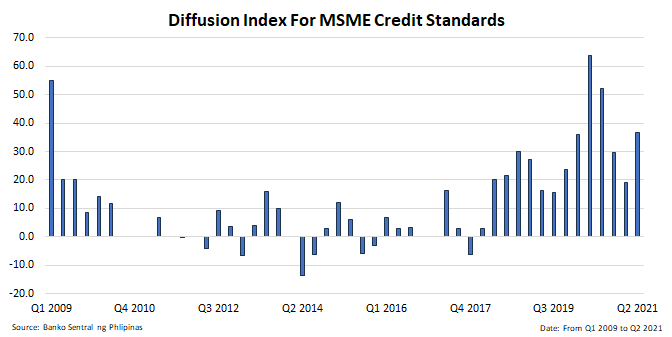MONDAY MACRO: Lending an ear to the banks shows how one sector has yet to recover

Even with some government assistance, the MSME sector has remained one of the hardest hit sectors by the COVID-19 pandemic.
By looking at how banks are lending to the sector, it seems that MSMEs will continue to face hardship, at least for the near-term.
Philippine Markets Daily:
The Monday Macro Report
Powered by Valens Research
According to the Department of Trade and Industry’s (DTI) survey in June 2021, 10% of micro, small, and medium enterprises (MSMEs) have shut down operations, down from 40% in August 2020.
In addition, 50% of respondents are still partially operating, while only around 40% are already fully operating. Worse, more than half have reported continued declines in sales.
Given their limited capital, MSMEs have struggled to adapt to the rapidly changing environment and the pandemic restrictions. Most had to rethink their whole business model or tweak their operations through the implementation of work-from-home setups, skeletal workforces, door-to-door deliveries, more product offerings, and cost-cutting.
In order to assist the sector, the Philippine government had granted a PHP 120 billion credit guarantee for businesses to remain in operations with further help from PhilGuarantee, which opened more than PHP 655 billion credit guarantee lines since the lockdown. PhilGuarantee had also waived penalty fees in accordance with the Bayanihan to Heal as One Act.
However, as indicated by the DTI’s survey, the government’s business relief measures have not been enough. Supporting the business sector is fruitless if demand continues to be crippled and consumers are still financially distressed.
As such, the government has been looking to pass the Bayanihan 3 bill into law, a PHP 401 billion relief package that would mainly provide PHP 2,000 to each Filipino.
This support in consumer spending will likely benefit the MSMEs, which make up 99.5% of the country’s businesses.
Furthermore, MSMEs generate around 60% of the country’s total employment and actually make up 40% of the Philippines’ GDP.
Since MSMEs greatly suffered last year, it is no wonder 2020 Philippine GDP contracted by 9.6%, a contrast from the 6% growth rate in 2019. Last year’s decline was also the largest since 1946, surpassing even the 1980s crash or Asian financial crisis.
Since banks are more privy to the MSMEs’ current financial and operational performance, looking at the changes in lending standards should provide a glimpse of the present status of MSMEs.
In order to gauge that, we used the Senior Bank Loan Officers’ Survey (SLOS), a survey conducted by Bangko Sentral ng Pilipinas (BSP) to measure the nation’s credit activity and show whether banks have been tightening or easing credit standards.

Since the creation of the SLOS in 2009, a net of 12% of banks have historically tightened credit standards for MSMEs each quarter. In Q2 2020, the index was at record-high levels, with 63.8% of banks tightening credit standards.
The lockdown restrictions had materially elevated the default risk of MSMEs. However, as the country adjusted to the situation, changes to lending standards gradually moderated back toward historical averages through Q1 2021.
Unfortunately, because of the periodic return of past restrictive quarantine measures, the index jumped again to 36.6% in Q2 2021.
Although current levels are nowhere near its Q2 2020 peak, the index continues to hover above historical averages. This implies that credit risk remains heightened, and that lending would be unlikely or costly for MSMEs.
As a result, the MSME sector’s chances of leading the country’s recovery look slim in the near term.
Even worse, Metro Manila is set to return to an Enhanced Community Quarantine (ECQ) again for another two weeks on August 6. The Socioeconomic Planning Secretary forecasts the Philippine economy to lose PHP 210 billion over the period.
MSMEs will likely bear the brunt of the ECQ’s impact, which will continue to make banks pessimistic. This reason and its recent trend suggest the index will likely remain elevated.
About the Philippine Markets Daily
“The Monday Macro Report”
When just about anyone can post just about anything online, it gets increasingly difficult for an individual investor to sift through the plethora of information available.
Investors need a tool that will help them cut through any biased or misleading information and dive straight into reliable and useful data.
Every Monday, we publish an interesting chart on the Philippine economy and stock market. We highlight data that investors would normally look at, but through the lens of Uniform Accounting, a powerful tool that gets investors closer to understanding the economic reality of firms.
Understanding what kind of market we are in, what leading indicators we should be looking at, and what market expectations are, will make investing a less monumental task than finding a needle in a haystack.
Hope you’ve found this week’s macro chart interesting and insightful.
Stay tuned for next week’s Monday Macro report!
Regards,
Angelica Lim
Research Director
Philippine Markets Daily
Powered by Valens Research
www.valens-research.com




